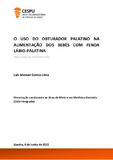O USO DO OBTURADOR PALATINO NA ALIMENTAÇÃO DOS BEBÉS COM FENDA LÁBIO-PALATINA
Resumo
Introdução: As fendas lábio-palatinas (FLP) consistem numa deformidade craniofacial congénita devido à falta de fusão entre as estruturas que precedem à formação do lábio e/ou palato. O obturador palatino (OP) é uma opção de reabilitação, ajudando na capacidade de sucção e alimentação.
Objetivo: Descrição das técnicas de confeção de um OP e sua importância como auxiliar da alimentação dos bebés com fenda lábio-palatina.
Material e Métodos: Realizamos uma pesquisa bibliográfica entre 2010 e 2022, na base de dados PubMed. Após a seleção e leitura dos artigos, elaborou-se uma tabela de resultados.
Resultados: A regurgitação nasal e a sucção ineficaz foram os principais problemas encontrados. Para a confeção do OP, a maioria preconiza a impressão em duas etapas (preliminar para obter a moldeira individual), ambas com silicone putty. O OP pode ser confecionado com placas etileno-vinil-acetato (EVA) ou em resina acrílica.
Discussão: A FLP não exclui o aleitamento materno. O OP encerra o defeito do palato duro/mole, melhorando a efetividade da sucção. O tratamento protético é exigente e requer procedimentos que garantam a segurança. Inclui dupla impressão, com confeção de uma moldeira individual, sendo o silicone putty o material de eleição. O método a vácuo é bastante simples, porém o de resina acrílica permite adaptações e uma sucção mais efetiva.
Conclusão: A reabilitação da fenda lábio-palatina com o OP melhora a qualidade de vida. O de resina acrílica oferece uma plataforma rígida necessária para a sucção, em detrimento do conforto que pode ser alcançado com um acondicionador de tecidos. Introduction: Cleft lip and palate (CLP) is a congenital craniofacial deformity due to the lack of fusion between the structures that precede the formation of the lip and/or palate. The palatal obturator (PO) is an option for rehabilitation, helping with sucking and feeding adequately.
Objective: Describe the palatal obturator manufacturing techniques and its importance as an aid to feeding babies with cleft lip and palate.
Materials and Methods: A bibliographic search was performed between 2010 e 2022, in the PubMed database. After the selection of the articles, a table of results was prepared.
Results: Nasal regurgitation and ineffective suction were the main eating problems found in the studies. For the manufacture of the palatal obturator, two-step impression technique is recommended (preliminary impression to make the individual tray), both with silicone putty. The palatal obturator can be made using the thermoplastic ethylene vinyl acetate (EVA) sheet or acrylic resin.
Discussion: CLP does not exclude breastfeeding. The PO closes the hard/soft palate defect, improving the effectiveness of suction. The prosthetic treatment is demanding and requires procedures that ensure safety. It includes a double impression, with an individual tray. Silicone putty is the material of choice. The vacuum method is quite simple, but the acrylic resin one allows adaptations and a more effective suction.
Conclusions: The prosthetic rehabilitation of cleft lip and palate with PO improve their quality of life. The acrylic resin PO offers a rigid platform needed for suctioning, rather than the comfort that can be achieved with a tissue conditioner.

